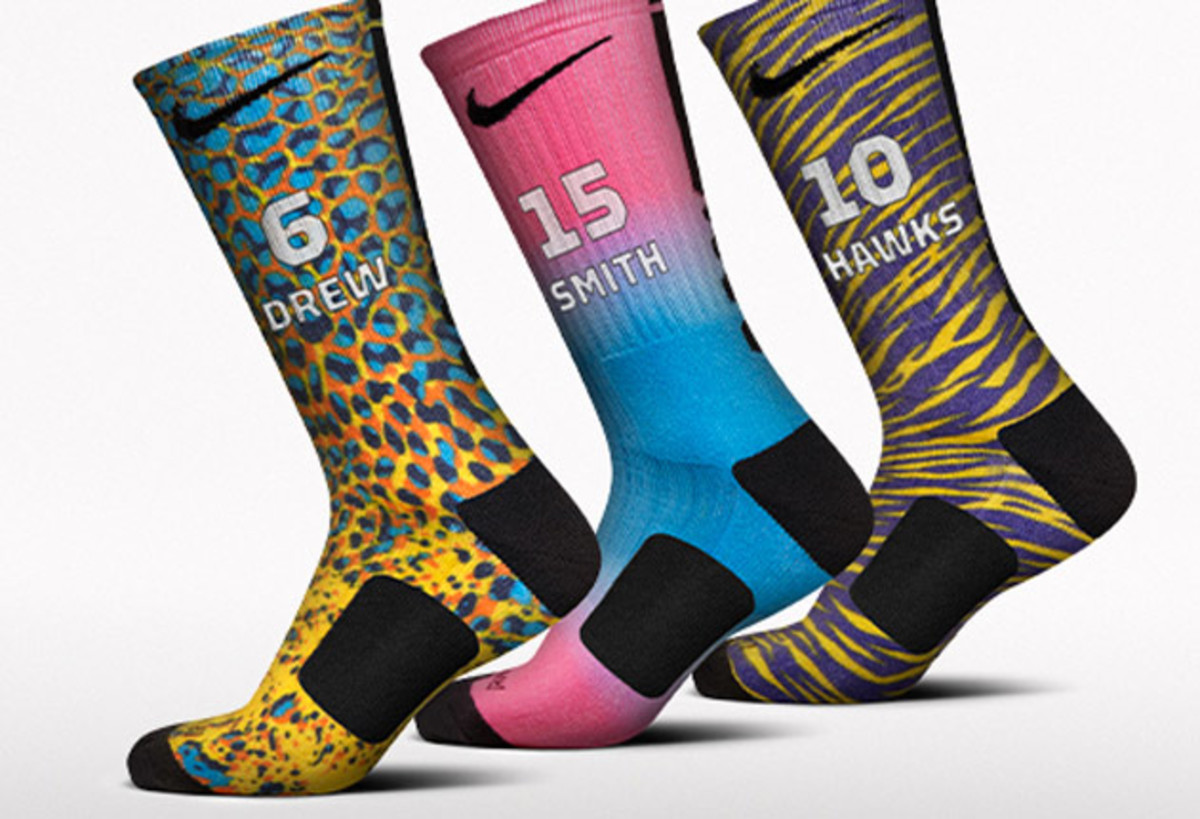High-tech basketball socks reach new heights with Nike iD customization

Yarn. When used traditionally, yarn creates a mundane garment null of shape or function. But when technology is infused with yarn’s properties, garments take shape, mold and develop specific functions. Basketball socks present the perfect example.
While technology first entered the socks realm for running and hiking, Nike unveiled its Elite series for basketball in 2007, releasing an anatomically shaped sock full of cushioning, ventilation and support.The latest versions, including the Hyper Elite, have evolved in the last eight-plus years as sock technology continues to develop.
In fact, the socks industry has expanded so much that Nike is introducing Nike iD customization for the first time in socks, beginning on April 28 with personalization available in the Nike Fade Elite Basketball Crew, KD Electric Eel and Kobe Flight Pack, with the LeBron line soon to follow.
Amy Frazer, a Nike senior designer and product lead for socks, tells SI.com that her company has “come a long way in technical innovations” for sock construction and yarn technology.
No longer is one type of yarn alone good enough to create a sock. The Elite uses nine bobbins (spindle or cylinder) of yarn per sock and the Hyper Elite ups the bobbin count to 13. With the Dri-FIT fabric of 70 percent polyester, 24 percent nylon, 4 percent cotton and 2 percent Spandex, Nike is able to build in multi-density cushioning, sweat wicking, ventilation, compression, support and multiple colors.
• MORE NBA: SI.com's Sneaker Hub: Latest shoe coverage

Cushioning, though, that is where everything starts. “What we have discovered with players is they love cushioning,” Frazer says, “in the heel and the forefoot. Where they are landing, where they jump off and land. They want more cushioning.”
While cushioning the toe area protects athletes when cutting and stopping and starting, it also appears around the ankle, Achilles tendon and pressure points. “We really need to think about (the sock) 360 degrees,” she says. “We are going as thick as we possibly can.”
Michael Jordan's game worn, signed rookie shoes sell for $71,533
But you can’t just pack a sock full of cushioning, you’d miss out on ventilation and support. “Where are they getting hot spots, where do they need ventilation?” Fraser asks. “Do we take out cushioning and put in support or ventilation?”
Using different fibers, Nike works to balance the cushioning, support and ventilation. “Think about if you are wearing supportive hose, you want your feet to feel fresh and supported,” Frazer says. “We have some different techniques we can play with in terms of construction and different yarns we play with.”
Throughout the sock, the multi-density cushioning appears on the heel and top of the foot, high durability yarn gets featured in high-friction zones and arch support and thick ribbing ads security, Spandex also gives stretch and compression in the midfoot to also keep cushioning in place and maximize left/right-specific design.
When Nike pioneered the technical basketball sock—the early versions were debuted by Team USA in 2007 and for retail by 2010—most players were using tube or crew socks, sometimes wearing four layers just to get a taste of comfort.
Since the early introduction, Nike has continued its research on socks, learning more about the interplay between the athlete and sock and sock and sneaker. As Nike strives to “discover how the shoe and sock work together,” they have matched ventilation in the sock to ventilation in sneakers to help the foot breath, ultimately working to give a more comfortable and lightweight component.
As Nike builds on the performance aspect of the basketball sock, the Oregon-based company doesn’t want to give up any ground aesthetically. Nike socks famously boast the "elite mark" on the rear side, which is a purely aesthetic feature, but a favorite. “It has that vertical movement to it,” Fraser says. “It looks faster.”
The debut of digital ink in the Nike iD allows even more options for sock color without hindering performance properties. “The cushioning, ventilation, you are not sacrificing performance with the aesthetics,” she says. “You get that magic spot. I think with the new process it will open creatively where we can play around with different inks, different ways of printing.”
As for the next iteration of the elite mark, though, don’t expect it to remain static. “For future variations, I’m not saying it is not going to be purely aesthetic,” Fraser says. “There could be a performance attribute to it. That is one thing I think we are challenged to do: keep the look and performance fresh.”
Tim Newcomb covers stadiums, design and gear for Sports Illustrated. Follow him on Twitter at @tdnewcomb.
